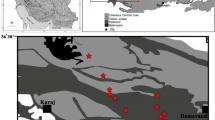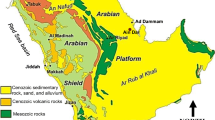Abstract
The ratios M R = E/σ c for 11 heterogeneous carbonate (dolomites, limestones and chalks) rock formations collected from different regions of Israel were examined. Sixty-eight uniaxial compressive tests were conducted on weak-to-strong (5 MPa < σ c < 100 MPa) and very strong (σ c > 100 MPa) rock samples exhibiting wide ranges of elastic modulus (E = 6100–82300 MPa), uniaxial compressive strength (σ c = 14–273.9 MPa), Poisson's ratio (ν = 0.13–0.49), and dry bulk density (ρ = 1.7–2.7 g/cm3). The observed range of M R = 60.9–1011.4 and mean value of M R = 380.5 are compared with the results obtained by Deere (Rock mechanics in engineering practice, Wiley, London, pp 1–20, 1968) for limestones and dolomites, and the statistical analysis of M R distribution is performed. Mutual relations between E, σ c, ρ, M R for all studied rocks, and separately for concrete rock formations are revealed. Linear multiple correlations between E on the one hand and σ c and ρ on the other for Nekorot and Bina limestone and Aminadav dolomite are obtained. It is established that the elastic modulus and M R in very strong carbonate samples are more correlated with ρ−σ c combination and ε a max, respectively, than in weak to strong samples. The relation between M R and maximum axial strain (ε a max) for all studied rock samples (weak-to-strong and very strong) is discussed.





Similar content being viewed by others
References
ACI (1989) Building code requirements for reinforced concrete (ACI 318-89). American Concrete Institute, Detroit
Al-Shayea NA (2004) Effect of testing methods and conditions on the elastic properties of limestone rock. Eng Geol 74:139–156
Deere DU (1968) Geological considerations. In: Stagg KG, Zienkiewicz OC (eds) Rock mechanics in engineering practice. Wiley, London, pp 1–20
Gokceoglu C, Zorlu K (2004) A fuzzy model to predict the uniaxial compressive strength and modulus of elasticity of problematic rocks. Eng Appl Artif Intell 17(1):61–72
Haldane JBS (1919) The combination of linkage values and the calculation of distances between the loci of linked factors. Genetics 8:299–309
Hatzor YH, Palchik V (1998) A microstructure—based failure criterion for Aminadav dolomites. Int J Rock Mech Min Sci 35(6):797–805
ISRM (1981) Rock characterization testing and monitoring. In: Brown ET (ed) ISRM suggested methods. Pergamon Press, Oxford
Ocak I (2008) Estimating the modulus of elasticity of the rock material from compressive strength and unit weight. J S Afr Inst Min Metall 108(10):621–629
Palchik V (1999) Influence of porosity and elastic modulus on uniaxial compressive strength in soft brittle porous sandstones. Rock Mech Rock Eng 32(4):303–309
Palchik V (2006) Stress-strain model for carbonate rocks based on Haldane’s distribution function. Rock Mech Rock Eng 39(3):215–232
Palchik V (2007) Use of stress-strain model based on Haldane’s distribution function for prediction of elastic modulus. Int J Rock Mech Min Sci 44(4):514–524
Palchik V, Hatzor YH (2004) The influence of porosity on tensile and compressive strength of porous chalks. Rock Mech Rock Eng 37(4):331–341
Sonmez H, Tuncay E, Gokceoglu C (2004) Models to predict the uniaxial compressive strength and the modulus of elasticity for Ankara agglomerate. Int J Rock Mech Min Sci 41(5):717–729
Sonmez H, Gokceoglu C, Nefeslioglu HA, Kayabasi A (2006) Estimation of rock modulus: for intact rocks with an artificial neural network and for rock masses with a new empirical equation. Int J Rock Mech Min Sci 43(2):224–235
Vasarhelyi B (2005) Statistical analysis of the influence of water content on the strength of the Miocene limestone. Rock Mech Rock Eng 38(1):69–76
Author information
Authors and Affiliations
Corresponding author
Rights and permissions
About this article
Cite this article
Palchik, V. On the Ratios between Elastic Modulus and Uniaxial Compressive Strength of Heterogeneous Carbonate Rocks. Rock Mech Rock Eng 44, 121–128 (2011). https://doi.org/10.1007/s00603-010-0112-7
Received:
Accepted:
Published:
Issue Date:
DOI: https://doi.org/10.1007/s00603-010-0112-7




